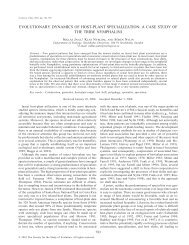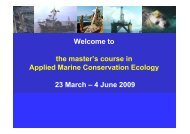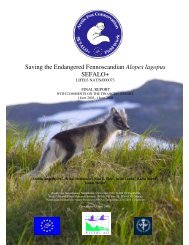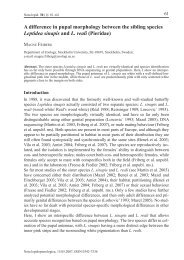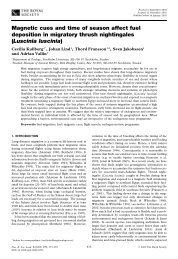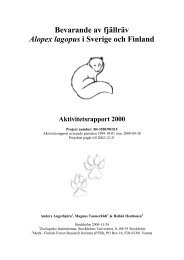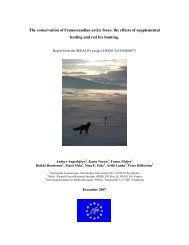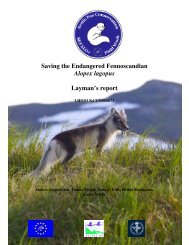Food-niche overlap between arctic and red foxes
Food-niche overlap between arctic and red foxes
Food-niche overlap between arctic and red foxes
You also want an ePaper? Increase the reach of your titles
YUMPU automatically turns print PDFs into web optimized ePapers that Google loves.
1284 Can. J. Zool. Vol. 80, 2002Barth, L., Angerbjörn, A., <strong>and</strong> Tannerfeldt, M. 2000. Are Norwegianlemmings Lemmus lemmus avoided by <strong>arctic</strong> Alopex lagopus or<strong>red</strong> Vulpes vulpes <strong>foxes</strong>? A feeding experiment. Wildl. Biol. 6:101–109.Birks, J.D.S., <strong>and</strong> Penford, N. 1990. Observations on the ecologyof <strong>arctic</strong> <strong>foxes</strong> Alopex lagopus in Eqalummiut Nunaat, WestGreenl<strong>and</strong>. Medd. Groenl. Biosci. 32: 1–26.Brom, T.G. 1986. Microscopic identification of feathers <strong>and</strong> featherfragments of Pale<strong>arctic</strong> birds. Bijdr. Dierkd. 56: 181–204.Chesemore, D.L. 1968. Notes on the food habits of <strong>arctic</strong> <strong>foxes</strong> innorthern Alaska. Can. J. Zool. 46: 1130–1227.Chirkova, A.F. 1968. The relationship <strong>between</strong> <strong>arctic</strong> fox <strong>and</strong> <strong>red</strong>fox in the far north. Probl. North, 11: 129–131.Clode, D., <strong>and</strong> Macdonald, D.W. 1995. Evidence for food competition<strong>between</strong> mink (Mustela vision) <strong>and</strong> otter (Lutra lutra) onScottish isl<strong>and</strong>s. J. Zool. (Lond.), 237: 435–444.Colwell, R.K., <strong>and</strong> Futuyma, D.J. 1970. On the measurement of<strong>niche</strong> breadth <strong>and</strong> <strong>overlap</strong>. Ecology, 52: 567–576.Dalerum, F., <strong>and</strong> Angerbjörn, A. 2000. Arctic fox (Alopex lagopus)diet in Karupelv valley, East Greenl<strong>and</strong>, during a summer withlow lemming diversity. Arctic, 53: 1–8.Dalerum, F., Tannerfeldt, M., Elmhagen, B., Becker, D., <strong>and</strong>Angerbjörn, A. 2002. Distribution, morphology <strong>and</strong> use of densin northern Sweden. Wildl. Biol. 8. In press.Day, M.G. 1966. Identification of hair <strong>and</strong> feather remains in thegut <strong>and</strong> faeces of stoats <strong>and</strong> weasels. J. Zool. (1965–1984), 148:201–217.Ecke, F., Löfgren, O., Hörnfeldt, B., Eklund, U., Ericsson, P., <strong>and</strong>Sörlin, D. 2001. Abundance <strong>and</strong> diversity of small mammals inrelation to structural habitat factors. Ecol. Bull. 49: 165–171.Elmhagen, B., Tannerfeldt, M., Verucci, P., <strong>and</strong> Angerbjörn, A.2000. The <strong>arctic</strong> fox (Alopex lagopus)—an opportunistic specialist.J. Zool. (Lond.), 251: 139–149.Elton, C.S. 1924. Periodic fluctuations in the numbers of animals:their causes <strong>and</strong> effects. Br. J. Exp. Biol. (1923–1929), 2: 119–163.Englund, J. 1965. Studies on food ecology of the <strong>red</strong> fox (Vulpesvulpes) in Sweden. [In Swedish with English summary.] Viltrevy(Stockh.), 3: 377–485.Englund, J. 1970. Some aspects of reproduction <strong>and</strong> mortality ratesin Swedish <strong>foxes</strong> (Vulpes vulpes) 1961–63 <strong>and</strong> 1966–69. [InSwedish with English summary.] Viltrevy (Stockh.) 8: 1–82.Fay, F.H., <strong>and</strong> Stephenson, R.O. 1989. Annual, seasonal <strong>and</strong> habitatrelatedvariation in feeding habits of the <strong>arctic</strong> fox (Alopex lagopus)on St. Lawrence Isl<strong>and</strong>, Bering Sea. Can. J. Zool. 67: 1986–1994.Frafjord, K. 1993. <strong>Food</strong> habits of <strong>arctic</strong> <strong>foxes</strong> (Alopex lagopus) onthe western coast of Svalbard. Arctic, 46: 49–54.Frafjord, K. 1995. Summer food habits of <strong>arctic</strong> <strong>foxes</strong> in the alpineregion of southern Sc<strong>and</strong>inavia, with a note on sympatric <strong>red</strong><strong>foxes</strong>. Ann. Zool. Fenn. 32: 111–116.Frafjord, K. 2000. Do <strong>arctic</strong> <strong>and</strong> <strong>red</strong> <strong>foxes</strong> compete for food? Z.Saeugetierkd. 65: 350–359.Frafjord, K., Becker, D., <strong>and</strong> Angerbjörn, A. 1989. Interactions<strong>between</strong> <strong>arctic</strong> <strong>and</strong> <strong>red</strong> <strong>foxes</strong> in Sc<strong>and</strong>inavia—p<strong>red</strong>ation <strong>and</strong>aggression. Arctic, 42: 354–356.Goszczynski, J. 1974. Studies on the food of <strong>foxes</strong>. Acta Theriol.19: 1–18.Hanski, I., Hansson, L., <strong>and</strong> Henttonen, H. 1991. Specialist p<strong>red</strong>ators,generalist p<strong>red</strong>ators, <strong>and</strong> the microtine cycle. J. Anim. Ecol. 60:535–367.Hersteinsson, P., <strong>and</strong> Macdonald, D.W. 1982. Some comparisons<strong>between</strong> <strong>red</strong> <strong>and</strong> <strong>arctic</strong> <strong>foxes</strong>, Vulpes vulpes <strong>and</strong> Alopex lagopus,as revealed by radio tracking. Symp. Zool. Soc. Lond. No. 49.pp. 259–289.Hersteinsson, P., <strong>and</strong> Macdonald, D.W. 1992. Interspecific competition<strong>and</strong> the geographical distribution of <strong>red</strong> <strong>and</strong> <strong>arctic</strong> <strong>foxes</strong>Vulpes vulpes <strong>and</strong> Alopex lagopus. Oikos, 64: 505–515.Hersteinsson, P., <strong>and</strong> Macdonald, D.W. 1996. Diet of <strong>arctic</strong> <strong>foxes</strong>(Alopex lagopus) in Icel<strong>and</strong>. J. Zool. (Lond.), 240: 457–474.Hersteinsson, P., Angerbjörn, A., Frafjord, K., <strong>and</strong> Kaikusalo, A.1989. The <strong>arctic</strong> fox in Fennosc<strong>and</strong>ia <strong>and</strong> Icel<strong>and</strong>: managementproblems. Biol. Conserv. 49: 67–81.Hurlbert, S.H. 1978. The measurement of <strong>niche</strong> <strong>overlap</strong> <strong>and</strong> somerelatives. Ecology, 59: 67–77.Jepsen, J.U., Eide, N.E., Prestrud, P., <strong>and</strong> Jacobsen, L.B. 2002. Theimportance of prey distribution in habitat use by <strong>arctic</strong> <strong>foxes</strong>(Alopex lagopus). Can. J. Zool. 80: 418–429.Kaikusalo, A., <strong>and</strong> Angerbjörn, A. 1995. The <strong>arctic</strong> fox populationin Finnish Lapl<strong>and</strong> during 30 years, 1964–93. Ann. Zool. Fenn.32: 69–77.Kapel, C.M.O. 1999. Diet of <strong>foxes</strong> (Alopex lagopus) in Greenl<strong>and</strong>.Arctic, 52: 289–293.Korhonen, H., Alasuutari, S., Mäkinen, A., <strong>and</strong> Niemelä, P. 1997.Inter- <strong>and</strong> intraspecific competition <strong>between</strong> the fox species Alopexlagopus <strong>and</strong> Vulpes vulpes: an evaluation trial under pennedconditions. Polar Biol. 17: 330–336.Krebs, C.J. 1989. Ecological methodology. Harper & Row, NewYork.L<strong>and</strong>a, A., Str<strong>and</strong>, O., Linnell, J.D.C., <strong>and</strong> Skogl<strong>and</strong>, T. 1998.Home-range sizes <strong>and</strong> altitude selection for <strong>arctic</strong> <strong>foxes</strong> <strong>and</strong>wolverines in an alpine environment. Can. J. Zool. 76: 448–457.Larivière, S., <strong>and</strong> Pasitschniak-Arts, M. 1996. Vulpes vulpes. Mamm.Species No. 537. pp. 1–11.Leckie, F.M., Thirgood, S.J., May, R., <strong>and</strong> Redpath, S.M. 1998.Variation in the diet of <strong>red</strong> <strong>foxes</strong> on Scottish moorl<strong>and</strong> in relationto prey abundance. Ecography, 21: 599–604.Lindström, E. 1982. Population ecology of the <strong>red</strong> fox (Vulpesvulpes) in relation to food supply. Ph.D. thesis, University ofStockholm, Stockholm, Sweden.Lindström, E. 1989. <strong>Food</strong> limitation <strong>and</strong> social regulation in a <strong>red</strong>fox population. Holarct. Ecol. 12: 70–79.Lindström, E. 1994. Large prey for small cubs—on crucial resourcesof a boreal <strong>red</strong> fox population. Ecography, 17: 17–22.Linnell, J.D.C., Str<strong>and</strong>, O., <strong>and</strong> L<strong>and</strong>a, A. 1999. Use of dens by <strong>red</strong>Vulpes vulpes <strong>and</strong> <strong>arctic</strong> Alopex lagopus <strong>foxes</strong> in alpine environments:Can interspecific competition explain the non-recoveryof Norwegian <strong>arctic</strong> fox populations? Wildl. Biol. 5: 167–176.Lockie, J.D. 1959. The estimation of the food of <strong>foxes</strong>. J. Wildl.Manag. 23: 224–227.Löfgren, S., <strong>and</strong> Angerbjörn, A. 1998. Åtgärdsprogram för fjällräv.[With English summary.] Rep. No. 620–9906, Swedish EnvironmentalProtection Agency, Stockholm.Lönnberg, E. 1927. Fjällrävsstammen i Sverige 1926. K. Sven.Vetenskapsakad. Skr. Naturskyddsarenden No. 7.Macpherson, A.H. 1964. A northward range extension of the <strong>red</strong>fox in the eastern Canadian Arctic. J. Mammal. 45: 138–140.Macpherson, A.H. 1969. The dynamics of Canadian <strong>arctic</strong> fox populations.Can. Wildl. Serv. Rep. Ser. No. 8.Marsh, D.B. 1938. The influx of the <strong>red</strong> fox <strong>and</strong> its colour phasesinto the Barren L<strong>and</strong>s. Can. Field-Nat. 52: 60–61.Niethammer, J., <strong>and</strong> Krapp, F. 1982. H<strong>and</strong>buch der Säugetiere Europas.B<strong>and</strong> 2/1. Nagetiere II. Akademische Verlagsgesellschaft, Wiesbaden,Germany.Oksanen, L., <strong>and</strong> Oksanen, T. 1992. Long-term microtine dynamicsin north Fennosc<strong>and</strong>ian tundra: the vole cycle <strong>and</strong> the lemmingchaos. Ecography, 15: 226–236.© 2002 NRC Canada



